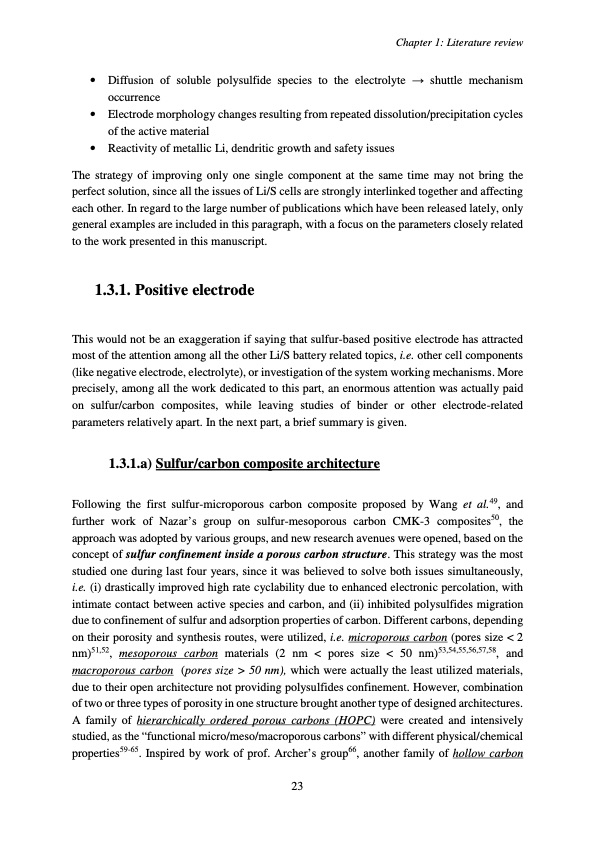
PDF Publication Title:
Text from PDF Page: 027
• Diffusion of soluble polysulfide species to the electrolyte → shuttle mechanism occurrence • Electrode morphology changes resulting from repeated dissolution/precipitation cycles of the active material • Reactivity of metallic Li, dendritic growth and safety issues The strategy of improving only one single component at the same time may not bring the perfect solution, since all the issues of Li/S cells are strongly interlinked together and affecting each other. In regard to the large number of publications which have been released lately, only general examples are included in this paragraph, with a focus on the parameters closely related to the work presented in this manuscript. 1.3.1. Positive electrode This would not be an exaggeration if saying that sulfur-based positive electrode has attracted most of the attention among all the other Li/S battery related topics, i.e. other cell components (like negative electrode, electrolyte), or investigation of the system working mechanisms. More precisely, among all the work dedicated to this part, an enormous attention was actually paid on sulfur/carbon composites, while leaving studies of binder or other electrode-related parameters relatively apart. In the next part, a brief summary is given. 1.3.1.a) Sulfur/carbon composite architecture Following the first sulfur-microporous carbon composite proposed by Wang et al.49, and further work of Nazar’s group on sulfur-mesoporous carbon CMK-3 composites50, the approach was adopted by various groups, and new research avenues were opened, based on the concept of sulfur confinement inside a porous carbon structure. This strategy was the most studied one during last four years, since it was believed to solve both issues simultaneously, i.e. (i) drastically improved high rate cyclability due to enhanced electronic percolation, with intimate contact between active species and carbon, and (ii) inhibited polysulfides migration due to confinement of sulfur and adsorption properties of carbon. Different carbons, depending on their porosity and synthesis routes, were utilized, i.e. microporous carbon (pores size < 2 nm)51,52, mesoporous carbon materials (2 nm < pores size < 50 nm)53,54,55,56,57,58, and macroporous carbon (pores size > 50 nm), which were actually the least utilized materials, due to their open architecture not providing polysulfides confinement. However, combination of two or three types of porosity in one structure brought another type of designed architectures. A family of hierarchically ordered porous carbons (HOPC) were created and intensively studied, as the “functional micro/meso/macroporous carbons” with different physical/chemical properties59-65. Inspired by work of prof. Archer’s group66, another family of hollow carbon Chapter 1: Literature review 23PDF Image | Accumulateur Lithium Soufre

PDF Search Title:
Accumulateur Lithium SoufreOriginal File Name Searched:
WALUS_2015_archivage.pdfDIY PDF Search: Google It | Yahoo | Bing
Sulfur Deposition on Carbon Nanofibers using Supercritical CO2 Sulfur Deposition on Carbon Nanofibers using Supercritical CO2. Gamma sulfur also known as mother of pearl sulfur and nacreous sulfur... More Info
CO2 Organic Rankine Cycle Experimenter Platform The supercritical CO2 phase change system is both a heat pump and organic rankine cycle which can be used for those purposes and as a supercritical extractor for advanced subcritical and supercritical extraction technology. Uses include producing nanoparticles, precious metal CO2 extraction, lithium battery recycling, and other applications... More Info
| CONTACT TEL: 608-238-6001 Email: greg@infinityturbine.com | RSS | AMP |